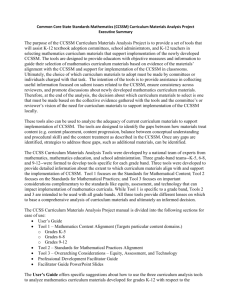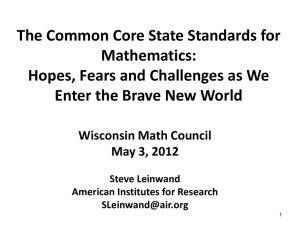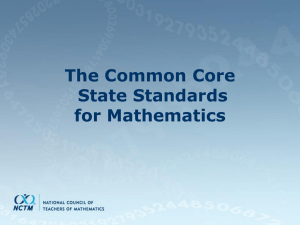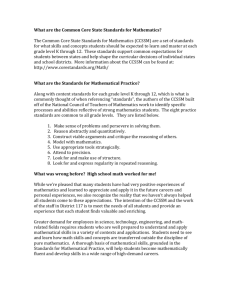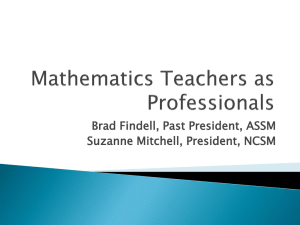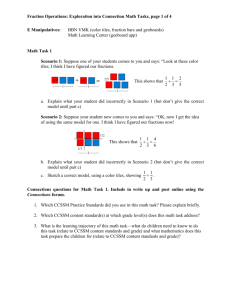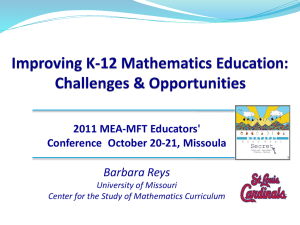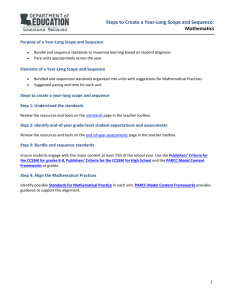Mathematics Teacher Educators Supporting Prospective Teachers
advertisement
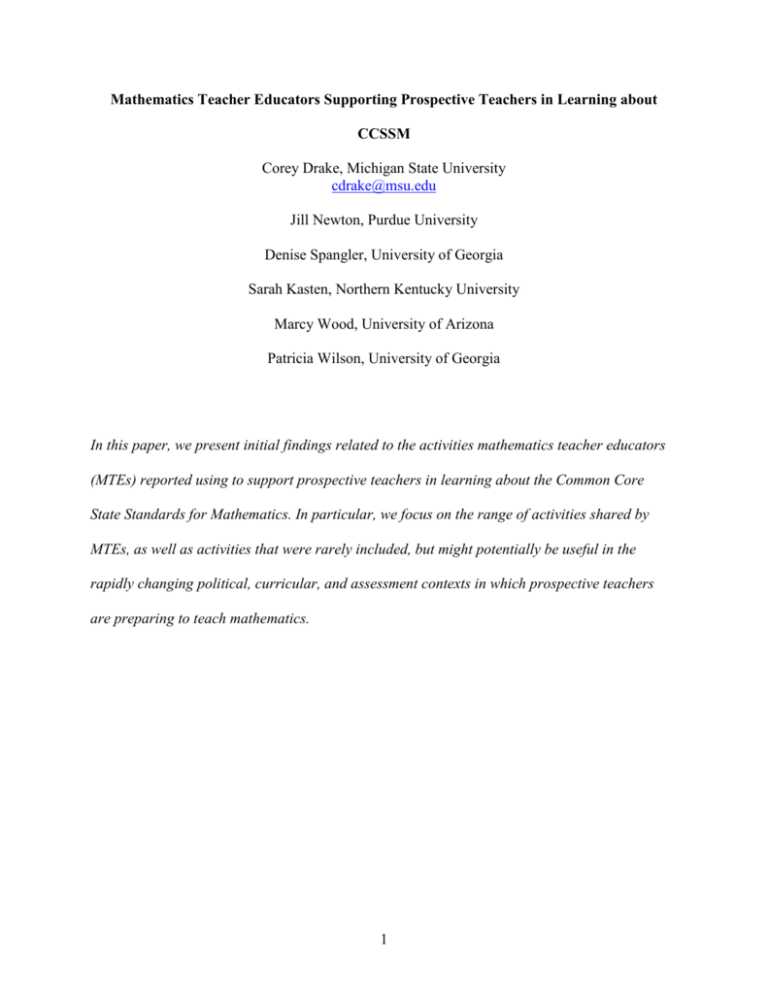
Mathematics Teacher Educators Supporting Prospective Teachers in Learning about CCSSM Corey Drake, Michigan State University cdrake@msu.edu Jill Newton, Purdue University Denise Spangler, University of Georgia Sarah Kasten, Northern Kentucky University Marcy Wood, University of Arizona Patricia Wilson, University of Georgia In this paper, we present initial findings related to the activities mathematics teacher educators (MTEs) reported using to support prospective teachers in learning about the Common Core State Standards for Mathematics. In particular, we focus on the range of activities shared by MTEs, as well as activities that were rarely included, but might potentially be useful in the rapidly changing political, curricular, and assessment contexts in which prospective teachers are preparing to teach mathematics. 1 Introduction Historically, there has been substantial variation in the design and content of courses and experiences intended to prepare teachers to teach mathematics (Taylor & Ronau, 2006). The recent adoption of Common Core State Standards for Mathematics (CCSSM) (NGA & CCSSO, 2010) by 45 states has prompted a national-level conversation about mathematics standards, providing an opportunity for diverse teacher education programs to investigate how different curricula and experiences in teacher education can prepare teachers to implement common standards. Studies of prior standards movements suggest that the relationship between policy and implementation is complex and implementation does not always align with what was intended by policy makers (e.g., Hill, 2001; Spillane, 2006). We are investigating how mathematics teacher educators (MTEs) see their roles in educating teachers in this era of common standards. In particular, our research focuses on the activities MTEs use to engage prospective teachers with CCSSM and MTEs’ goals and rationales for those activities. One assumption behind the development and implementation of CCSSM was that – as a common set of standards adopted across many states – CCSSM has the potential to effect largescale change in the teaching and learning of mathematics in grades K-12. This assumption is documented by the authors of CCSSM as well as in reports from a variety of organizations and researchers (e.g., Conference Board of the Mathematical Sciences, 2012; Confrey, & Krupa, 2010; Heck, Weiss, & Pasley, 2011; Krupa, 2011). In addition to changes in K-12 classrooms, we have evidence that CCSSM is also influencing the teacher preparation classrooms. It is critical to understand the rationale behind the changes. The literature related to sense making of educational policy and standards (e.g., Hill, 2001; Spillane, 2006; Wilson, 2002) suggests that understanding how individuals and groups make sense of and understand policies, 2 including standards and curriculum, is important for understanding how these policies are ultimately implemented in K-12 classrooms. Understanding the rationale of MTEs is equally important. Research on sense making and the implementation of mathematics standards has been conducted with teachers and administrators at school and district levels, but rarely with MTEs. In our study, we focus on MTEs who are preparing PSTs in states that have adopted the CCSSM. MTEs face a particularly challenging task in that they are preparing PSTs for a system in which there are many different meanings, interpretations, and representations of CCSSM. Part of MTEs’ sense making and implementation process, then, is to make choices among these interpretations. Prior work on sense making (e.g., Drake, 2006; Weick, 2000) suggests that these decisions might be influenced by personal stories and experiences, policy tools (including descriptions and representations), and local contexts (including available resources and constraints, as well as prevalent, local interpretations). In this paper, we focus in particular on the kinds of activities that MTEs described using to prepare their PSTs to teach mathematics in the context of CCSSM. Data Sources and Methods Our research is being conducted in several phases and we report on the first two phases here. First, we collected prior research and presentations related to CCSSM and, more specifically, to ways in which MTEs are teaching about CCSSM in their work with PSTs. We used a key word approach to search conference programs and identify relevant materials. We then developed a framework for analyzing those activities. This framework focused on the ways in which CCSSM is used in mathematics education courses, including the different representations of CCSSM that MTEs share with PSTs, the positioning of CCSSM relative to the NCTM Principles and Standards (2000), the centrality of CCSSM in the MTEs’ activities, and 3 the extent to which the activities seemed to be newly developed to support PSTs’ learning about CCSSM versus adapted to accommodate or align with CCSSM. Based in part on our analytic framework, as well as prior research, we developed a survey for mathematics teacher educators to learn more about the activities and goals in their classes. Nearly 400 MTEs from 45 states responded to some or all of the survey, with 210 providing responses about activities and 266 providing responses to about their goals with respect to prospective teachers and CCSSM. Respondents represented a range of positions, including those in education and mathematics departments, secondary and elementary, with responsibilities for methods courses and/or content courses. Findings Using a process of open and emergent coding, we analyzed MTEs’ responses concerning their goals and activities related to CCSSM, and we are beginning to analyze the connections between the goals and activities. Through these analyses, we have identified themes that characterize how MTEs are making sense of the kinds of experiences necessary for the preparation of prospective teachers to work in school districts implementing CCSSM. With respect to MTEs’ goals for prospective teachers, we have identified a range from familiarity/awareness to understanding to use (See Wood et al., 2014). In some cases, these goals referred to the CCSSM generally, while in other cases, respondents identified specific features, elements, or characteristics of the CCSSM that prospective teachers should know about, understand, and/or use. Similarly, the activities MTEs report using with prospective teachers range from 1) “Getting to Know” CCSSM and becoming familiar with them (including discussions of the history of standards and CCSSM and/or the structure of the document and/or studying the 4 progressions of content within CCSSM) to 2) positioning CCSSM in relation to other sets of standards, including through comparisons to other sets of standards, to 3) finding, or aligning, CCSSM in various representations of teaching – including curriculum materials, tasks, video, and observed teaching, to 4) using CCSSM to plan and teach lessons. Some MTEs also described engaging PSTs in mathematics activities that supported the PSTs in experiencing the content and/or practices of CCSSM as learners, while others asked PSTs to search for and identify resources that might be useful in enacting CCSSM. Many MTEs listed multiple activities, often across the range of categories described above. Within each of these activities, CCSSM was framed in a variety of ways ranging from endorsement to critique and from a pedagogical document to a political document. Implications We are interested in the insights that our analyses and findings provide about the roles of MTEs in the implementation of CCSSM and of standards and policies more generally. MTEs play significant roles in preparing teachers to implement policies and standards such as CCSSM. Many times, though, MTEs are positioned, or position themselves, not only as policy interpreters and implementers, but also as policy critics. As Grossman and colleagues have noted, MTEs are often faced with the tension of preparing teachers for current K-12 education contexts, while also working to change those contexts through research, professional development, and other means (Grossman et al., 2008). As CCSSM continue to be both adopted and rejected in states and as new CCSSM-aligned assessments and curriculum materials are developed, it will be important to continue to understand the role(s) of MTEs in the process of CCSSM implementation. We are particularly interested in tracking the ways in which MTEs work to prepare PSTs in three specific areas related to CCSSM: 5 1) Navigating the expanding marketplace of curriculum materials, particularly on-line materials, that are marketed as CCSSM-aligned. How do PSTs learn to evaluate the accuracy of these claims, to identify features of materials aligned and not aligned with CCSSM, and to enact instruction that uses these materials to provide opportunities for students to engage in CCSSM content and practices? 2) Preparing students for CCSSM-related assessments. What kinds of opportunities do MTEs provide for PSTs to learn about CCSSM-related assessments? 3) Understanding the political contexts of CCSSM. What kinds of preparation are MTEs providing PSTs in terms of understanding – and critiquing – the political aspects of CCSSM, as well as the public discourse that accompanies these political aspects? While each of these areas was mentioned by some MTE respondents in the survey, the numbers were small relative to descriptions of activities intended to familiarize PSTs with CCSSM, help PSTs identify CCSSM content and practices in representations of teaching, allow PSTs to experience CCSSM as learners, and incorporate CCSSM in lesson plans. This is despite the fact that 57% of respondents stated that it is “very important” for PSTs to have opportunities to analyze curriculum materials with respect to CCSSM, 73% agreed or strongly agreed that the success of CCSSM will depend on the associated assessments, and 59% agreed or strongly agreed that CCSSM is a political document. In future phases of this study, we conjecture that issues of curriculum, assessment, and politics may become more prominent as these contexts become increasingly relevant to MTEs and PSTs. 6 References Drake, C. (2006). Turning points: Using mathematics life stories to understand the implementation of mathematics education reform. Journal of Mathematics Teacher Education 9(6): 579-608. Grossman, P., McDonald, M., Hammerness, K., & Ronfeldt, M. (2008). Dismantling dichotomies in teacher education. In M. Cochran-Smith, S. Feiman-Nemser & D.J. McIntyre (Eds.), Handbook of research on teacher education: Enduring questions in changing contexts, Third edition. New York: Routledge. Heck, D. J., Weiss, I. R., & Pasley, J. D. (2011). A priority research agenda for understanding the influence of the Common Core State Standards for Mathematics. Chapel Hill, NC: Horizon Research, Inc. Hill, H. C. (2001). Policy is not enough: Language and the interpretation of state standards. American Educational Research Journal, 38(2), 289-318. Krupa, E. (2011). A summary report from the conference “Moving Forward Together: Curriculum & Assessment and the Common Core State Standards for Mathematics.” Arlington, VA, April-May, 2011. NGA & CCSSO. (2010). Common core state standards for mathematics. Washington, DC: Authors. Spillane, J. P. (2006). Standards deviation: How schools misunderstand education policy. Cambridge, MA: Harvard University Press. Taylor, P. M., & Ronau, R. (2006). Syllabus study: A structured look at mathematics methods courses. AMTE Connections, 16(1), 12-15. Weick, K.E. (1995). Sensemaking in Organizations. Thousand Oaks, CA: Sage Publications, Inc. 7 Wood, M.B., Wilson, P.S., Kasten, S.E., Drake, C., Newton, J.A. & Spangler, D.A. (2014). Goals of mathematics teacher educators for prospective teachers and the CCSSM. Paper presented at the Annual Meeting of the American Educational Research Association, Philadelphia, PA. 8
